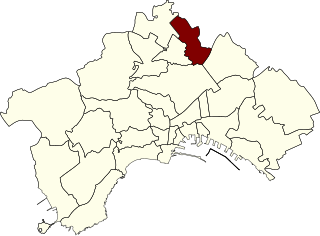Colonnella is a comune in the Province of Teramo in the Italian region Abruzzo of eastern Italy. It is part of the Unione dei comuni Città Territorio-Val Vibrata.
This is a list of music conservatories in Naples, Italy.

Spaccanapoli is the straight and narrow main street that traverses the old, historic center of the city of Naples, Italy. The name is a popular usage and means, literally, "Naples splitter". The name is derived from the fact that it is very long and from above it seems to divide that part of the city.

San Lorenzo Maggiore is a church in Naples, Italy. It is located at the precise geographic center of the historic center of the ancient Greek-Roman city, at the intersection of via San Gregorio Armeno and via dei Tribunali. The name "San Lorenzo" may also refer to the new museum now opened on the premises, as well as to the ancient Roman market beneath the church itself, the Macellum of Naples.

Castel Capuano is a castle in Naples, southern Italy. It takes its name from the fact that it was at that point in the city walls where the road led out to the city of Capua. The castle is at the southwest end of via dei Tribunali, and until recently housed the Naples Hall of Justice, which has now moved to the new Civic Center, the Centro Direzionale.

Via dei Tribunali is a street in the old historic center of Naples, Italy.

Pendino is one of the 30 quartieri of Naples, southern Italy.

Vicaria, often known as Il Vasto, is one of the 30 quartieri of Naples, southern Italy, lying immediately to the east of the historical city centre.

Poggioreale is a neighbourhood of Naples, southern Italy. It is at the extreme east end of the downtown Naples and includes the central train station, Centro Direzionale, Poggioreale prison, and the industrial area to the east.

Secondigliano is a modern suburb in the north of Naples, Campania, Italy. It is part of the 7th municipality of Naples, along with the suburbs of Miano and San Pietro a Patierno.

Zona Industriale, is a quarter of Naples, Italy. With Poggioreale, San Lorenzo, and Vicaria it forms the Fourth Municipality of the city.

The historic center, or Centro Storico, of Naples, Italy represents the historic nucleus of the city, spanning 27 centuries.

Arenaccia is a historical neighborhood or zona of the Fourth Municipality of northeastern Naples, Italy. Its name derives from the Via Arenaccia road that divides the neighborhoods of San Lorenzo and Vicaria, which covers the area. The east–west boundaries are represented roughly by the Piazza Carlo III and the Corso Malta, while the north-west boundaries are represented from the beginning and end of the Via Arenaccia.

Santa Maria della Mercede e Sant'Alfonso Maria de' Liguori is a Roman Catholic church located in via San Sebastiano #1 in the historic center of Naples, Italy. It rises on the South-Eastern corner of the intersection of Via San Sebastiano - Via Santa Maria di Constantinopoli, and the Vico San Pietro da Maiella and the outlet of the Via Port'Alba, a narrow alley starting at the medieval gate of Port'Alba. The Vico San Pietro da Maiella feeds into the southernmost end of Via dei Tribunali, corner with via San Sebastiano, and on the Vico, neighboring to the east and behind the church, stands the Conservatory of San Pietro a Majella.

San Giorgio Maggiore is a basilica church located on the corner of Via vicaria Vecchia and Via Duomo, in central Naples, Italy. The apse of the church lies diagonally across the street from San Severo al Pendino.

The Macellum of Naples was the macellum or market building of the Roman city of Neapolis, now known as Naples. Due to the rise of the ground level the macellum is now located beneath the church of San Lorenzo Maggiore. The first construction dates to 5th or 4th century BC when the area was the location of the agora during the Greek period. When Neapolis became a Roman possession it was eventually transformed into a macellum. This structure was covered by a mudslide in the 5th century AD, probably as a result of flooding.

The Piazza Bellini is a plaza located in central Naples, Italy. The Via Santa Maria di Costantinopoli runs along its western side. A block to the south is the Decumanus Maximus.
The Decumano or Decumanus Superiore was one of the three main east-west roads (Decumani) in the Ancient Roman city of Naples.

The Palazzo Ricca is a monumental palace, located on the southernmost end of Via dei Tribunali #213, in central Naples, region of Campania, Italy. It presently houses the archives of the Foundation of the Istituto Banco di Napoli. The palace is just down the street from the entrance to Castel Capuano

The Vico, and Vicoletto, of Zuroli, more commonly called Vicolo dei Zuroli are two historic alleys located in the historic center of the city of Naples, they are located near Via Forcella, near the church of Pio Monte della Misericordia, art museum and historical place of Naples since 2005, between Via dei Tribunali and Via Vicaria Vecchia, in the Pendino district.

















